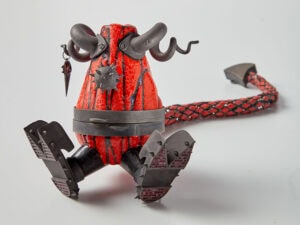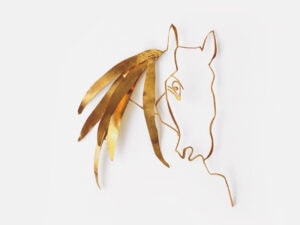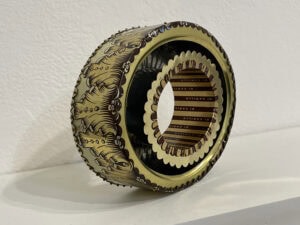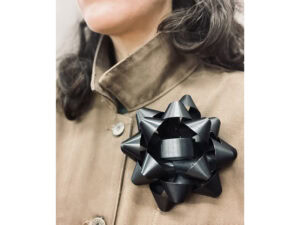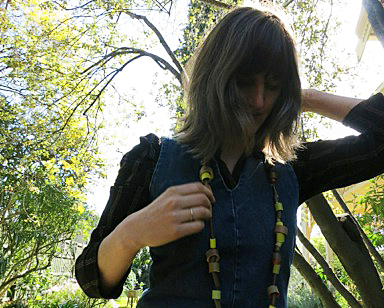
Susan Cummins: Can you tell me how you came to make jewelry?
Sally Marsland: When I was 12 I obsessively drew house plans and elevations on 5-mm graph paper, carefully placing windows and doors and furniture etc. I decided the logical conclusion was to become an architect. I followed this through to university, and then fell in a huge heap part way through as it dawned on me that perhaps the obsessive drawing had been a symbol of something else. I was studying architecture at RMIT University in Melbourne, and after a year of depression, I started in the jewelry course there. I studied at RMIT for five years and worked with the late Melbourne sculptor Akio Makigawa (husband of jeweler Carlier Makigawa) while I set up my own practice. I studied for two years with Otto Künzli in Munich. Since 2000, I have been back in Melbourne where I work and live with my husband Stephen Bram, an abstract painter, and our two sons.

Sally Marsland: Both.
It is a wonderful quote from a book called Missing Out – In Praise of the Unlived Life by Adam Phillips. Has this book meant a lot to you?
Sally Marsland: Oh, it is a sensational book. Not that I am going to pretend I understand it all. Every time I return to it, another layer unfolds. Essentially, Phillips writes about frustration and how we are enriched through an understanding of our disappointments, missed opportunities, unfulfilled desires, etc. He is a psychoanalyst and a compelling writer—never didactic or dry—with an ability to write sentences that go straight to the nervous system then creep around inside you for days. I just had a look on Google, and this interview gives you a good sense of the book.
You produced a catalog for this show, and your text was written in a very introspective voice. It had a questioning and revealing perspective that was a pleasure to read, and much of what you discussed can apply both to making work and to living life.
Sally Marsland: Thanks! I have been a jeweler for 16 years now. I am generally obsessive in my work practices, and my actions show I have always been clearly committed to my profession. But, you would never guess that if you only had the things I say to go by. I am always voicing doubts and insecurities. It’s a bit like driving with a foot on the accelerator and the brake at the same time. I think too much. I get stuck both in details and wanting to understand the big picture (although always missing obvious bits). I pull myself in too many directions, often literally. If I am not doing yoga three to four times a week, my muscles physically pull me out of alignment. Of course, I would rather be a calm and centered person—funnily enough, people sometimes tell me that is how I appear—but, oooh weee, that is not my internal experience. While it is important the vagaries of my mental life do not permeate the actual things that I make, (who would want to wear them?) I felt there was a space in this catalog to reflect about some of this in relation to the work.
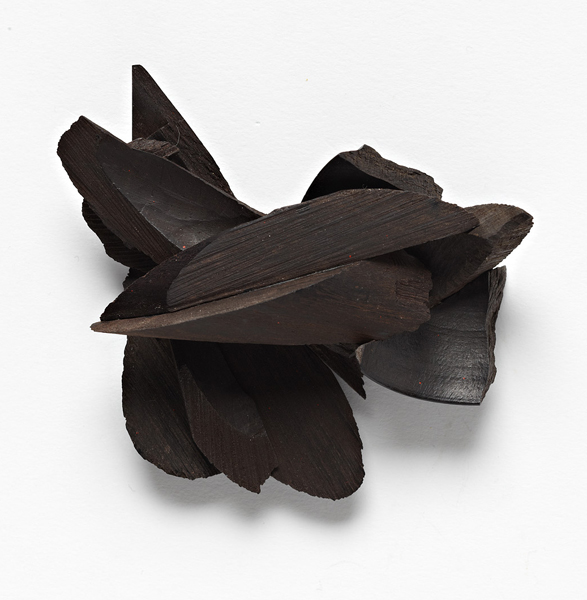
Sally Marsland: For my 2006 work, Jewellery made with holes, I wrote that I:
… understand less and less how anything gets made. There are so many choices, and yet so many things already exist. I try to make things as simply as possible, but don’t always succeed. Some things take a long time to conceive and/or craft, others emerge apparently fast. In relation to how/why/what to make in jewelry, thinking about holes seems as good a place as any to start. Even in their material absence, holes are concrete. Or at least, using them as a starting point gives permission to proceed without saying where to go.
You don’t seem to want to have jewelry be anything but “objects to adorn a body,” but you are also very curious about the intertwining of how you make things with what you make. How do you describe your jewelry? Does that describe you as well?
Sally Marsland: You are right that I am curious about the interrelationships between … everything! But, somehow your question makes me wriggle around so much that I will try to avoid it by instead quoting part of a text on the work I just mentioned. This is by Melbourne artist and writer Michael Graf. I hope you do not mind. 🙂
Sally Marsland’s Jewellery made with holes, 2006
Tweaking a minimalist mode with great insight, Sally Marsland’s collection of objects is made to physically adorn and imaginatively enhance. Never seeking large gestures, her work is like a poem by e.e. cummings: everything is in lower case. This is evident in the sometimes-abject nature of the materials she employs plus the canny use of found objects. A pair of hollow bones or a discarded wooden object sits alongside the more familiar materials of the contemporary jeweler. “If one has enough milk in the house, one doesn’t go to the grocery store,” observed the composer Stefan Wolpe about his own working habits. Likewise, what is immediately at hand can be transformed by Marsland’s exacting vision to arrive at an object with the right contour, density of color, surface texture…” Michael Graf
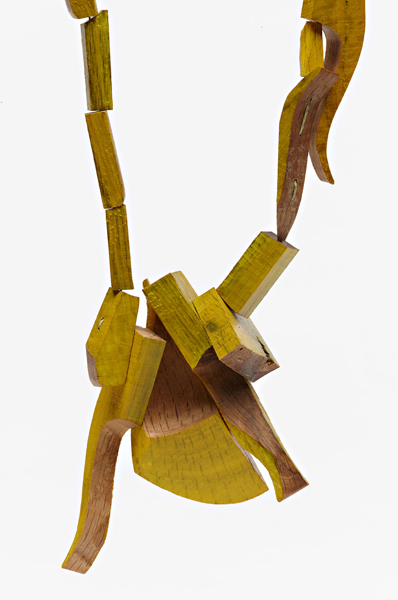
The jewelry in the show that is made by cutting up wooden bowls and things that you have found is wonderfully familiar but almost unrecognizable. You seem to be very reluctant to make the cuts in these old things, and yet you do. Why?
Sally Marsland: My jewelry has always had the same preoccupations. What is a group? How can I make a new one? How can I draw on what I already know and surprise myself? What moves me? What do I need to do to feel like something is mine? I love materials and problem solving. What can they do? How do I like to physically work? For example, early on I liked reductive processes, such as using a metal lathe and carving. I liked to stand in one place at the lathe, and see how many different kinds of little brooches I could turn from a rod of aluminum. I also liked casting and the way liquids took on the forms of other things. I hated constructing things, especially from flat sheets. Making things fit together really hurt my teeth and brain.
And yet in the past two years, as you say, I find myself cutting wooden vessels and painstakingly combining some of the elements to make a new whole. It is absurd, and I really find parts of it unpleasant. They are very slow to make. I overcome the discomfort because I feel a compulsion to do it and I find other parts of the process very exciting. As I say in the catalog, I get to look very closely and carefully at some incredibly beautiful complex curves, to see how they change when I cut through them, and to imagine how best to combine them with others.
A long time ago, I saw an Ellsworth Kelly photo of a snow covered field ending as a smoothly delineated curve against the edge of a forest. It is not often far from my consciousness. My breath still suspends every time I imagine it, and the memory retains its affect. I like that feeling very much. Especially, of course, when the breath comes back …

Sally Marsland: Oh! Your questions make me feel like my catalog text has given you a sense that my working life is misery. May I please also say I love my work, and I love making things? I am so in the soup of me, if that makes sense. We are all frogs cooking in our own pots. I think I am okay with struggling a lot. I love it when I see another person choosing to bring something I have made into his or her life or to give it to someone else. It makes the contradictions and hurdles I set myself disappear. Anyway, I am unable to do anything else!
I do think that with everything I make, write, or do, I am, on one level, doing the same thing—although please don’t ask me to tell you exactly what it is. I think I tried to show it through the text more than tell it. I am a believer in the repetition compulsion; that many of our actions involve playing out much earlier experiences, drives, and dynamics. Of course, my understanding of the concept is pretty limited, but I like to think of it as being fairly well summarized by an episode of The Simpsons in which Bart electrifies a beer can in the kitchen. Homer comes in, looks delighted as he spots the can, and says, “hmmm, beer!” only to be lit up with shock and sparks as he grasps it. He staggers out several times, returns moments later each time, and sees the can as if anew—“hmmm, beer!” etc., etc.
Sorry I keep moving away from your questions. Color has always been another preoccupation. It is so powerful and yet subjective. It changes the way we respond to identical forms. It moves us. It gets in the way, perhaps in a similar way that verbal language gets in the way of experiencing objects. We truncate our experiences because they have a faster pathway to our center. Pah—what do I know about what I am saying? I feel I have learned a little about color, but I still consider myself very poor in understanding it.
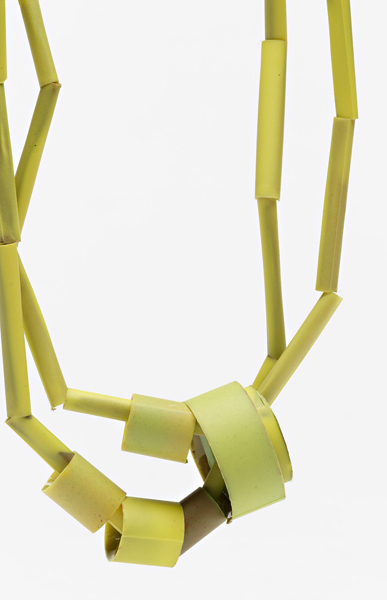
I make lots of beads in batches. Along the way, the outside of the mold gets covered with thin spillage and I forget what colors I have used. Often, I open the beads from the molds and think, “yuck … I have just wasted two days making that?” But, they join the other beads in little bowls on the threading table. And I find it amazing how many times it’s the “horrible” beads that make the necklaces work best. There are so many variables. It kind of does my head in, but it surprises me how much I enjoy the whole process. If someone told me a year ago I would be making long, decorative, haphazard assemblies of labor intensive beads, I would have been … not sure exactly, but certainly disbelieving. But, if I think of them in the context of all the works that preceded them, they are completely logical.
Is it possible to get a copy of your catalog? How?
Sally Marsland: You can buy the catalog through Jeweler’sWerk Galerie, Galerie Biro, Galerie Ra, Gallery Funaki, or Chrome Yellow Books.
Thank you.
Sally Marsland: Me, too, you.


